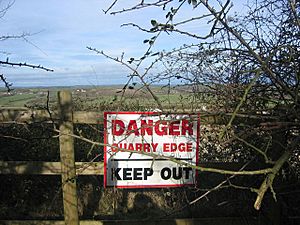Totternhoe Stone Pit facts for kids
| Site of Special Scientific Interest | |
 |
|
| Area of Search | Bedfordshire |
|---|---|
| Interest | Geological |
| Area | 2.1 hectares |
| Notification | 1996 |
| Location map | Magic Map |
Totternhoe Stone Pit is a special place in Totternhoe, Bedfordshire, England. It's known for its amazing geology, which means it's important for studying the Earth's history. This site is officially recognized as a Site of Special Scientific Interest (SSSI) because of its unique features.
What Makes Totternhoe Stone Pit Special?
Totternhoe Stone Pit is a very important location for scientists. It helps them learn about what the Earth was like millions of years ago. The site is a great example of a type of rock called the Totternhoe Stone. This stone is actually a kind of lime mud that formed a very long time ago.
Discovering Ancient Sea Creatures
One of the most exciting things about Totternhoe Stone Pit is what's hidden inside its rocks. Scientists have found many fossil shark teeth here! These teeth come from the late Cretaceous period, which was about 100 to 66 million years ago. This was the time when dinosaurs roamed the Earth, and the area where Totternhoe is now was covered by a warm, shallow sea.
Some of the shark teeth found here belong to species that scientists haven't fully described yet. This means Totternhoe Stone Pit is a super important place for new discoveries. The deeper parts of the pit have larger teeth, while higher up, you can find smaller teeth from ancient rays. Rays are fish that are related to sharks.
Protecting the Site
Because Totternhoe Stone Pit is so important for science, it's carefully protected. It's part of the larger Totternhoe nature reserve. This reserve is looked after by the Wildlife Trust for Bedfordshire, Cambridgeshire and Northamptonshire. They work hard to keep the area safe and healthy.
Even though it's part of a nature reserve, the Stone Pit itself isn't open to the public. This helps to protect the delicate geological features and fossils inside. It ensures that scientists can continue to study this amazing site for many years to come.

